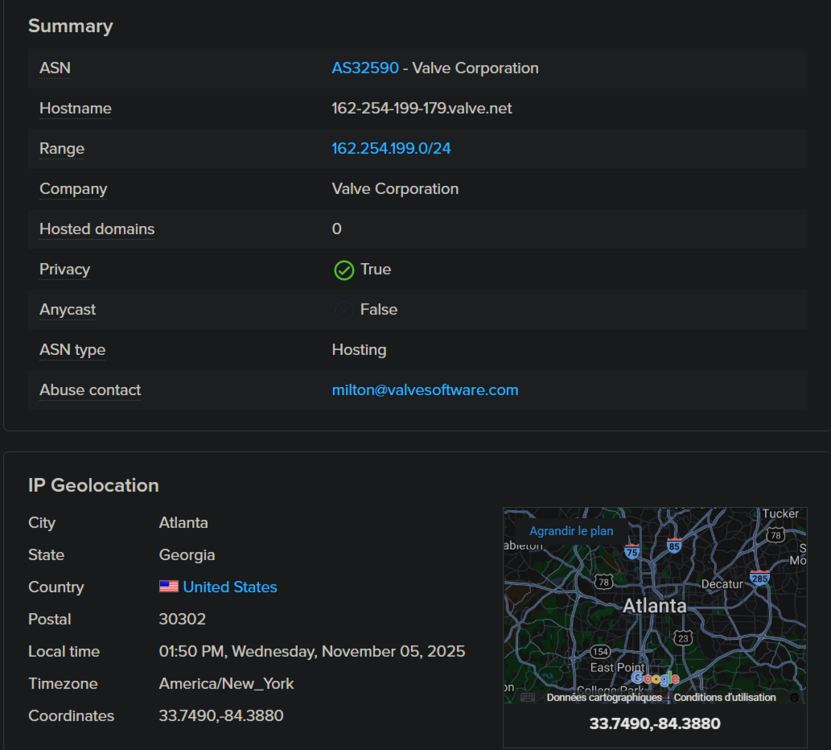-
Posts
413 -
Joined
-
Last visited
-
Days Won
2
KinGzzy last won the day on September 30 2023
KinGzzy had the most liked content!
Basic Info
-
Location
FR
-
Interests
LINUX / ADMIN / NETWORK
-
DumaOS Routers Owned
XR1000v2
Gaming
-
Gamer Type
PC Gamer
-
Connection Speed
1001mbps or higher
Recent Profile Visitors
The recent visitors block is disabled and is not being shown to other users.
-

Unable to connect to US servers since BO7 release
KinGzzy replied to pdoidy30's topic in Netduma R3 Support
Warzone.mp4 just with a Windows machine and a shell script -
.png) AsNCo reacted to a post in a topic:
No Longer Caught in the Rabbit Hole – My Best Settings for FPS Games
AsNCo reacted to a post in a topic:
No Longer Caught in the Rabbit Hole – My Best Settings for FPS Games
-

Unable to connect to US servers since BO7 release
KinGzzy replied to pdoidy30's topic in Netduma R3 Support
Where did you get that information? there is always an alternative -
Ah, okay, you can have your cake and eat it too. How much??
-
For the Netduma team. Here is the list of Battlefield 6 servers known to date before the update. Tested and approved by myself. define hostgroup { hostgroup_name North-America } define host { host_name DC-California address NA-CA check_latency 143 lat 36.7783 lon -119.4179 } define host { host_name DC-Virginia address NA-VA check_latency 86 lat 37.4316 lon -78.6569 } define host { host_name DC-Ohio address NA-OH check_latency 97 lat 40.4173 lon -82.9071 } define host { host_name DC-Oregon address NA-OR check_latency 155 lat 43.8041 lon -120.5542 } ------------------------------------------------------------ define hostgroup { hostgroup_name Europe } define host { host_name DC-Germany check_latency 20 lat 51.1657 lon 10.4515 } define host { host_name DC-UnitedKingdom check_latency 20 lat 55.3781 lon -3.4360 } define host { host_name DC-Ireland check_latency 29 lat 53.4129 lon -8.2439 } ------------------------------------------------------------ define hostgroup { hostgroup_name Asia } define host { host_name DC-HongKong check_latency 187 lat 22.3193 lon 114.1694 } define host { host_name DC-Japan check_latency 225 lat 36.2048 lon 138.2529 } define host { host_name DC-Singapore check_latency 155 lat 1.3521 lon 103.8198 }
-
 Netduma Fraser reacted to a post in a topic:
Battlefied 6 Atlanta Server not seen
Netduma Fraser reacted to a post in a topic:
Battlefied 6 Atlanta Server not seen
-
The NA servers are located in: California, Virginia, Ohio, Oregon, "no more, no less" No Georgia.
-
 Netduma Fraser reacted to a post in a topic:
Battlefied 6 Atlanta Server not seen
Netduma Fraser reacted to a post in a topic:
Battlefied 6 Atlanta Server not seen
-
For EU servers, they are mainly located in Germany and England.
-
quite
-
If it helps, the game points to the old EA servers before the migration to AWS servers, which leads to false leads. It will take longer than expected to geolocate all the servers. And that's assuming it even manages to connect to regions other than the client's (NA, APAC, EU, etc.).
-
-
.png) Iced Soul reacted to a post in a topic:
Is the Netduma R3 really the best router for me?
Iced Soul reacted to a post in a topic:
Is the Netduma R3 really the best router for me?
-
There are three possibilities, in my opinion. 1: Microsoft is using these servers, so they have a new public IP address and a new IP address range. (Everything needs to be redone on the geofilter side.) 2: Microsoft is still using AWS as a "hybrid backend" for some servers. In this case, some AWS IP addresses would remain valid (no total change). 3: If Microsoft uses "BYOIP" (Bring Your Own IP), this is a feature where a company brings its own IP addresses to the cloud (AWS, Azure, or other). In this case: The IP addresses belong to Activision/Microsoft, not the cloud provider. They can be used on both AWS and Azure. (Result: the player would see "the same IP addresses," even if technically the infrastructure has changed providers). PS: I'm not an expert but I think that Microsoft will use its ecosystem which in the long term is much more profitable but from memory I don't think that Azure is better established than AWS (e.g. South America) for Gaming. So we'll see.
-

Is the Netduma R3 really the best router for me?
KinGzzy replied to Iced Soul's topic in Call of Duty Support
On Windows, there isn't much you can do about the network. You can tag your applications with DSCP tags if your router supports packet prioritization using DSCP. Some people optimize their Windows using the registry. Google is your friend, but if you want, you can test software. Windows: Resource Monitor (resmon.exe) allows you to see which processes are consuming bandwidth. Third-party tools like NetLimiter or cFosSpeed allow you to limit or prioritize certain applications. Router: All routers these days, or 99% of them, have QOS. QoS → its main role is packet classification and prioritization (e.g., gaming > voice > download). Bandwidth control → is achieved through mechanisms such as HTB (Hierarchical Token Bucket), HFSC, or FQ_Codel/SQM, which manage efficient throughput distribution. To be more technically precise: QoS ≠ direct throughput management → it's a "who comes before whom" logic in the queue. HTB or equivalents → allow hierarchical classes to be defined with minimum and maximum bandwidth allocations (per user, per IP, per protocol). In modern routers (e.g., OpenWrt), the two are often combined: Classification (QoS) → to identify sensitive flows. Scheduling/Shaping (HTB, FQ_Codel, CAKE) → to efficiently allocate and limit bandwidth. So, to put it simply: QoS = packet priority. HTB/HFSC = bandwidth control = actual bandwidth allocation. For gaming, both are very important, especially if you're playing on a PC. Having a 240 Hz monitor isn't enough. Optimizing Windows is important to avoid input lag in games. And when it comes to networking, there's no magic formula: a very good ISP connection and a good router to prioritize game packets and other... In your case, that's gaming, especially Call of Duty. This means you need to make sure your game takes priority over other tasks. No packet loss, no buffering, and no excessive ping; your game remains the top priority, even when downloads are overloading your bandwidth. -
.png) Krush reacted to a post in a topic:
Is the Netduma R3 really the best router for me?
Krush reacted to a post in a topic:
Is the Netduma R3 really the best router for me?
-

Is the Netduma R3 really the best router for me?
KinGzzy replied to Iced Soul's topic in Call of Duty Support
On these beautiful words, take care of yourself and have a good evening. -

Is the Netduma R3 really the best router for me?
KinGzzy replied to Iced Soul's topic in Call of Duty Support
About the network card improving sound: we’re not talking about audio frequency or equalizers. None of that! Honestly, it shouldn’t even need explaining; anyone familiar with networking should know this. 2- I understood, don't worry, and I am very familiar with the network because I am currently a sysadmin. What I’m talking about is data packets transmitted from the server to your client. A network card that handles these packets and queues better ensures that the data arrives without delay. These packets carry critical info, like enemy footsteps and shot registration. With an efficient NIC, they don’t get delayed or ignored. 3 - In short, packet and delay management is actually shared at several levels: The Network Interface Card (NIC) It handles the reception and transmission of packets at the hardware level. It manages the queues of incoming/outgoing packets and applies certain optimizations (such as offloading, interrupt moderation, or buffering). A high-end network card can process packets faster, reduce latency, and prevent losses if the bandwidth is high. The Operating System (kernel network stack) The kernel (Windows, Linux, etc.) manages scheduling, buffering, and the transmission of packets at the software level. It’s the one that delivers packets to applications (your game, for example). The Network Protocol (TCP/UDP, etc.) UDP (often used for games) sends packets without delivery verification → faster but with a risk of packet loss. TCP guarantees delivery (retransmission, ordering), but adds latency. The Quality of the Network (routers, ISP, the Internet in general) Even with a good network card, if your connection is unstable, saturated, or poorly routed, you will experience latency or packet loss. If necessary, I can give you a course on how the network works from layer 1 to 7.



